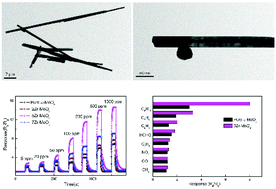The effects of Zr-doping on improving the sensitivity and selectivity of a one-dimensional α-MoO3-based xylene gas sensor
Abstract
In this work, one-dimensional (1D) α-MoO3 nanobelts and Zr-doped α-MoO3 nanobelts were facilely prepared via a simple hydrothermal method, and the gas sensing performance of the obtained products towards xylene vapor was tested systematically. The characterization results showed that Zr was successfully doped into the lattice of α-MoO3 without destroying the unique 1D nanobelt structure and existed as ball-like nanostructures scattered on the nanobelts. The data from the gas sensing test demonstrated that the Zr-doped α-MoO3-based sensor exhibited superior sensing performance with the response towards 100 ppm xylene at the optimum operating temperature of 206 °C reaching 7.99, which was nearly three-fold greater compared with that of the pristine α-MoO3-based sensor. Besides, the Zr-doped α-MoO3-based sensor possessed excellent selectivity and a low detection limit. The enhanced sensing performance could be attributed to the 1D nanostructure and the doped Zr. The mechanism of the enhancement of sensing properties induced by the Zr-doping strategy was also demonstrated specifically.



 Please wait while we load your content...
Please wait while we load your content...